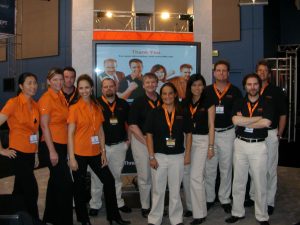Trade shows are an effective way for small businesses to connect with prospects who are interested in your products and services. They allow you to meet potential customers face-to-face and begin to establish personal connections—giving these events an advantage over remote marketing channels such as email campaigns and social media postings.
Timothy Carter, director of business development at AudienceBloom, a Seattle, Washington-based content and social media marketing firm, has these tips for making the most of trade shows:
1. Set objectives
Decide in advance what you hope to accomplish at the trade show. Instead of a generic goal like becoming better known within your industry, be specific. Goals such as acquiring names for your email list or demonstrating your product to 20 new people a day can keep you focused and help you measure your progress.
2. Choose the right show to attend
Find out what trade show your best prospects go to and put it at the top of your list. Check out the trade show’s website and perhaps contact the coordinator directly to get a clear idea of the type of people who attend. Carter even suggests getting in touch with exhibitors from last year’s show to see the success they had.
3. Do research at other trade shows
Attend a few trade shows yourself to see how other small businesses exhibit. This is especially important for members of your team who have never been to a trade show before. Look for ideas on how these businesses market themselves, the kinds of booths they use, and how they drive traffic to their exhibit.
4. Promote in advance
Before the trade show, use all your marketing channels to tell your current prospects and customers where and when you’ll be exhibiting. Build up excitement in the days and weeks leading up to the trade show, perhaps giving away a free surprise gift to anyone who stops by your booth.
Telling the reporters who cover your industry that you’ll be exhibiting at a particular trade show could lead to media coverage for your business.
5. Alert the press
Telling the reporters who cover your industry that you’ll be exhibiting at a particular trade show could lead to media coverage for your business. Have a press kit ready in advance and even suggest possible topics or angles for news stories.
6. Train your team
Prepare the people who are manning your exhibit to handle a variety of situations. For example, educate them on how to concisely explain what your company does, how to ask booth visitors qualifying questions, and describe the promotions you’re running at the show.
7. Design an attention-getting booth
Carter says that attendees should be able to see your booth from about 20 feet away and get a clear idea of what your business does just by looking at it. Have sales material ready to hand out.
8. Collect leads
Have some way to capture the names and contact information of prospects, such as holding a contest or offering a free demonstration in exchange for a business card.
9. Build interest with social media
Carter says that one member of your team should be designated as your social media reporter during the trade show, for example: sending tweets or posting videos and images about activities at your booth.
10. Network
Make time to leave your booth and network with other exhibitors and attendees. Taking a stroll through the exhibit hall or sharing a cup of coffee with another small business owner could lead to unexpected opportunities.
Investing the time and money in a well-coordinated exhibit at a trade show can be a vital part of your overall business-building and marketing strategy.
I don’t put talent into people. I help let it out. Contact me TODAY and let’s get you MOVING on the right track!
Roland Gilbert, CLCO (Chief Life-Change Officer)
The Perennial Growth Group
Dale Carnegie Certified Trainer & Performance Coach
My mission is to coach individuals for intentional, authentic living. This mission is accomplished through workshops, speaking, writing and coaching. For over 10 years I have trained leaders and have helped people grow. My experience includes working with several large manufacturing corporations, hundreds of individuals and groups, and as an active ministry worker of my church. Because of my diverse background I am able to help clients effectively address all aspects of life


